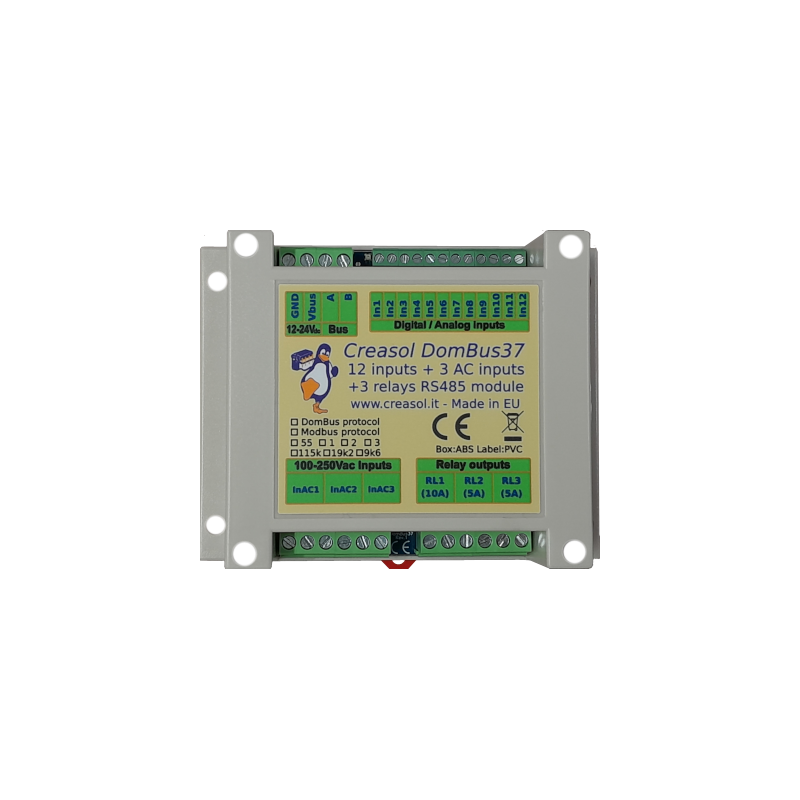
Creasol DomBusTH - Domoticz apparaat met temperatuur- en vochtigheidssensoren, 4 ingangen, 2 uitgangen, 3 leds
- Aanbieding!
- -25%
Email: store@creasol.it - Telegram: CreasolTech - Whatsapp: +393283730010
Priority mail: snel en goedkoop - Express Courie
Neem contact met ons op voordat u producten retourneert!

DIN RAIL-module, 115x90x40mm, ondersteunt beideDomBusEnModbus RTU-protocollen.
Het integreert12x laagspanning analoge/digitale ingangen, 3x relaisuitgangen, 3x 115Vac / 230Vac ingangen. Optioneel is het in staat om de voeding naar eeninbraakalarm externe sirene.Handig om inbraakalarmsystemen te maken met domotica-controllers zoals Domoticz, Home Assistant, OpenHAB, ...
 Volledige ondersteuning: de meeste producten zijn door ons ontworpen!
Volledige ondersteuning: de meeste producten zijn door ons ontworpen!
Email: store@creasol.it - Telegram: CreasolTech - Whatsapp: +393283730010
 Bestellingen worden binnen 1 werkdag verzonden
Bestellingen worden binnen 1 werkdag verzonden
Priority mail: snel en goedkoop - Express Courie
 24 maanden garantie, eenvoudig retourneren/restitueren
24 maanden garantie, eenvoudig retourneren/restitueren
Neem contact met ons op voordat u producten retourneert!
*** Volledige informatie ophttps://www.creasol.it/DomBus37***
Creasol DomBus37is eenDIN RAIL-module, 115x90x40mm, ondersteunt beideDomBusEnModbus RTU-protocollen.
Het integreert12x laagspanning analoge/digitale ingangen, 3x relaisuitgangen, 3x 115Vac / 230Vac ingangen. Optioneel is het in staat om de voeding naar eeninbraakalarm externe sirene.
Het kan worden aangesloten op de domotica-controller via een RS485 seriële bus (4 draden, 2 voor 12/24V-voeding en 2 voor data op 115200bps).
Net als andere DomBus-apparaten,DomBus37 is ontworpen om weinig stroom te verbruiken, betrouwbaar, volledig configureerbaar en gebruiksvriendelijk te zijn. Elke ingangspoort is volledig configureerbaar, bijvoorbeeld als analoge of digitale ingang, twinbutton (dubbele knop aangesloten op een enkele poort), teller, zoemer, NTC 10k, ... Analoge poorten kunnen single, double, triple, quadruple gebalanceerd decoderen alarmsensoren.
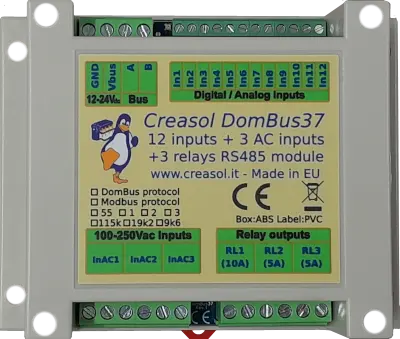
Volledige informatie en toepassingsnotities ophttps://www.creasol.it/DomBus37
Standaard adres: 0xff37
| Haven# | Naam | Mogelijkheden | Standaard configuratie | Beschrijving |
| 1 | IN 1 | IN_DIGITAL, IN_DIGITAL_PULLDOWN, IN_ANALOG, IN_TWINBUTTON, IN_COUNTER | IN_DIGITAL |
Input, met optionele 10k pullup (pcb jumper) en interne pulldown (geactiveerd indien geconfigureerd als IN_DIGITAL_PULLDOWN). Indien aangesloten op een enkele drukknopschakelaar of een alarmsensor, is de gemeenschappelijke GND (wanneer de schakelaar is ingeschakeld, moet de poort worden kortgesloten naar GND). Kan worden aangesloten op externe NTC-thermistor (lucht- of watertemperatuursensor). |
| 2 | IN 2 | IN_DIGITAL, IN_DIGITAL_PULLDOWN, IN_ANALOG, IN_TWINBUTTON, IN_COUNTER | IN_DIGITAL |
Input, met optionele 10k pullup (pcb jumper) en interne pulldown (geactiveerd indien geconfigureerd als IN_DIGITAL_PULLDOWN). Indien aangesloten op een enkele drukknopschakelaar of een alarmsensor, is de gemeenschappelijke GND(wanneer de schakelaar AAN staat, moet de poort worden kortgesloten naar GND). Kan worden aangesloten op externe NTC-thermistor (lucht- of watertemperatuursensor). |
| 3 | IN3 | IN_DIGITAL, IN_DIGITAL_PULLDOWN, IN_ANALOG, IN_TWINBUTTON, IN_COUNTER | IN_DIGITAL |
Input, met optionele 10k pullup (pcb jumper) en interne pulldown (geactiveerd indien geconfigureerd als IN_DIGITAL_PULLDOWN). Indien aangesloten op een enkele drukknopschakelaar of een alarmsensor, is de gemeenschappelijke GND (wanneer de schakelaar is ingeschakeld, moet de poort worden kortgesloten naar GND). Kan worden aangesloten op externe NTC-thermistor (lucht- of watertemperatuursensor). |
| 4 | IN4 | IN_DIGITAL, IN_DIGITAL_PULLDOWN, IN_ANALOG, IN_TWINBUTTON, IN_COUNTER | IN_DIGITAL |
Input, met optionele 10k pullup (pcb jumper) en interne pulldown (geactiveerd indien geconfigureerd als IN_DIGITAL_PULLDOWN). Indien aangesloten op een enkele drukknopschakelaar of een alarmsensor, is de gemeenschappelijke GND (wanneer de schakelaar is ingeschakeld, moet de poort worden kortgesloten naar GND). Kan worden aangesloten op externe NTC-thermistor(lucht- of watertemperatuursensor). |
| 5 | IN5 | IN_DIGITAL, IN_DIGITAL_PULLDOWN, IN_ANALOG, IN_TWINBUTTON, IN_COUNTER | IN_DIGITAL |
Input, met optionele 10k pullup (pcb jumper) en interne pulldown (geactiveerd indien geconfigureerd als IN_DIGITAL_PULLDOWN). Indien aangesloten op een enkele drukknopschakelaar of een alarmsensor, is de gemeenschappelijke GND (wanneer de schakelaar is ingeschakeld, moet de poort worden kortgesloten naar GND). Kan worden aangesloten op externe NTC-thermistor (lucht- of watertemperatuursensor). |
| 6 | IN6 | IN_DIGITAL, IN_DIGITAL_PULLDOWN, IN_ANALOG, IN_TWINBUTTON, IN_COUNTER | IN_DIGITAL |
Input, met optionele 10k pullup (pcb jumper) en interne pulldown (geactiveerd indien geconfigureerd als IN_DIGITAL_PULLDOWN). Indien aangesloten op een enkele drukknopschakelaar of een alarmsensor, is de gemeenschappelijke GND (wanneer de schakelaar is ingeschakeld, moet de poort worden kortgesloten naar GND). Kan worden aangesloten op externe NTC-thermistor (lucht- of watertemperatuursensor). |
| 7 | IN7 | IN_DIGITAL, IN_DIGITAL_PULLDOWN, IN_ANALOG, IN_TWINBUTTON, IN_COUNTER | IN_DIGITAL |
Input, met optionele 10k pullup (pcb jumper) en interne pulldown (geactiveerd indien geconfigureerd als IN_DIGITAL_PULLDOWN). Indien aangesloten op een enkele drukknopschakelaar of een alarmsensor, is de gemeenschappelijke GND (wanneer de schakelaar is ingeschakeld, moet de poort worden kortgesloten naar GND). Kan worden aangesloten op externe NTC-thermistor (lucht- of watertemperatuursensor). |
| 8 | IN8 | IN_DIGITAL, IN_DIGITAL_PULLDOWN, IN_ANALOG, IN_TWINBUTTON, IN_COUNTER | IN_DIGITAL |
Input, met optionele 10k pullup (pcb jumper) en interne pulldown (geactiveerd indien geconfigureerd als IN_DIGITAL_PULLDOWN). Indien aangesloten op een enkele drukknopschakelaar of een alarmsensor, is de gemeenschappelijke GND (wanneer de schakelaar is ingeschakeld, moet de poort worden kortgesloten naar GND). Kan worden aangesloten op externe NTC-thermistor (lucht- of watertemperatuursensor). |
| 9 | IN9 | IN_DIGITAL, IN_DIGITAL_PULLDOWN, IN_ANALOG, IN_TWINBUTTON, IN_COUNTER | IN_DIGITAL |
Input, met optionele 10k pullup (pcb jumper) en interne pulldown (geactiveerd indien geconfigureerd als IN_DIGITAL_PULLDOWN). Indien aangesloten op een enkele drukknopschakelaar of een alarmsensor, is de gemeenschappelijke GND (wanneer de schakelaar is ingeschakeld, moet de poort worden kortgesloten naar GND). Kan worden aangesloten op externe NTC-thermistor (lucht- of watertemperatuursensor). |
| 10 | IN10 | IN_DIGITAL, IN_DIGITAL_PULLDOWN, IN_ANALOG, IN_TWINBUTTON, IN_COUNTER | IN_DIGITAL |
Input, met optionele 10k pullup (pcb jumper) en interne pulldown (geactiveerd indien geconfigureerd als IN_DIGITAL_PULLDOWN). Indien aangesloten op een enkele drukknopschakelaar of een alarmsensor, is de gemeenschappelijke GND (wanneer de schakelaar is ingeschakeld, moet de poort worden kortgesloten naar GND). Kan worden aangesloten op externe NTC-thermistor (lucht- of watertemperatuursensor). |
| 11 | IN11 | IN_DIGITAL, IN_DIGITAL_PULLDOWN, IN_ANALOG, IN_TWINBUTTON, IN_COUNTER | IN_DIGITAL |
Input, met optionele 10k pullup (pcb jumper) en interne pulldown (geactiveerd indien geconfigureerd als IN_DIGITAL_PULLDOWN). Indien aangesloten op een enkele drukknopschakelaar of een alarmsensor, is de gemeenschappelijke GND (wanneer de schakelaar is ingeschakeld, moet de poort worden kortgesloten naar GND). Kan worden aangesloten op externe NTC-thermistor (lucht- of watertemperatuursensor). |
| 12 | IN12 | IN_DIGITAL, IN_DIGITAL_PULLDOWN, IN_ANALOG, IN_TWINBUTTON, IN_COUNTER, AANGEPAST | IN_DIGITAL |
Input, met optionele 10k pullup (pcb jumper) en interne pulldown (geactiveerd indien geconfigureerd als IN_DIGITAL_PULLDOWN). Indien aangesloten op een enkele drukknopschakelaar of een alarmsensor, is de gemeenschappelijke GND (wanneer de schakelaar is ingeschakeld, moet de poort worden kortgesloten naar GND). Kan worden aangesloten op externe NTC-thermistor (lucht- of watertemperatuursensor). |
| 13 | INAC1 | IN_AC, IN_COUNTER | IN_AC | Optisch geïsoleerdingang, die kan worden aangesloten op een stroomonderbreker (om stroomuitval te melden, met name voor koelkasten en warmtepompen), PIR's met 230V-uitgang (om aanwezigheid te bewaken), licht en apparaten (om te controleren wanneer licht of apparaten AAN zijn)./td> |
| 14 | INAC2 | IN_AC, IN_COUNTER | IN_AC | Opto-geïsoleerde ingang, die kan worden aangesloten op een stroomonderbreker (om stroomuitval te melden, met name voor koelkasten en warmtepompen), PIR's met 230V-uitgang (om aanwezigheid te bewaken), verlichting en apparaten (om te controleren wanneer licht of apparaten AAN zijn)./td> |
| 15 | INAC3 | IN_AC, IN_COUNTER | IN_AC | Opto-geïsoleerde ingang, die kan worden aangesloten op een stroomonderbreker (om stroomuitval te melden, met name voor koelkasten en warmtepompen), PIR's met 230V-uitgang (om aanwezigheid te bewaken), verlichting en apparaten (om te controleren wanneer licht of apparaten AAN zijn)./td> |
| 16 | RL1 | OUT_DIGITAL, UIT_RELAY_LP, OUT_BLIND,OUT_FLASH | OUT_RELAY_LP | SPST-relaisuitgang, NO-contact, 10A 250Vac of 30Vdc uitgangsvermogen. Relaiscontact is beveiligd door varistor. |
| 17 | RL2 | OUT_DIGITAL, OUT_RELAY_LP, OUT_BLIND,OUT_FLASH | OUT_RELAY_LP | SPST-relaisuitgang, NO-contact, 5A 250Vac of 30Vdc uitgangsvermogen. Relaiscontact is beveiligd door varistor. |
| 18 | RL3 | OUT_DIGITAL, OUT_RELAY_LP, OUT_BLIND(1),OUT_FLASH | OUT_RELAY_LP | SPST-relaisuitgang, NO-contact, 5A 250Vac of 30Vdc uitgangsvermogen. Relaiscontact is beveiligd door varistor. |
| 19 | VBus | AANGEPAST | AANGEPAST | 12-24V busspanning, in mW (bijvoorbeeld 13508 voor 13.508mV) |
| 20 | S.Volt | AANGEPAST | AANGEPAST | Spanning op de sirenepoort (IN12-klemmenblok) in mV. Raadpleeg de onderstaande paragraaf voor meer informatie. |
| 21 | S.Curr | AANGEPAST | AANGEPAST | Stroom op de sirenepoort (IN12-klemmenblok) in mA. Raadpleeg de onderstaande paragraaf voor meer informatie. |
| 22 | Zoon | AANGEPAST | AANGEPAST | Aan/uit-entiteit, om de stroomtoevoer naar de sirene in/uit te schakelen. Raadpleeg de onderstaande paragraaf voor meer informatie. |
| 23 | S.Staat | AANGEPAST | AANGEPAST | Sirene stroomstatus. Raadpleeg de onderstaande paragraaf voor meer informatie. |
(1): kan worden gebruikt als BLIND-uitgang om een jaloezie/gordijn te openen, maar alleen de vorige poort kan in Domoticz worden geconfigureerd als OUT_BLINDomdat, indien geconfigureerd als OUT_BLIND, het DomBus-apparaat automatisch de volgende poort configureert om een relais in open richting te sturen.
The following video shows a presentation of some domotic modules designed and produced in Italy by Creasol to make a reliable, easy and power-optimized home automation system.
The next video shows our Smart EVSE module that can be used to charge the electric car by using only solar power, or adding 25/50/75/100% of available power from the electrical grid.
Our industrial and home automation modules are designed to be
Modules are available in two version:
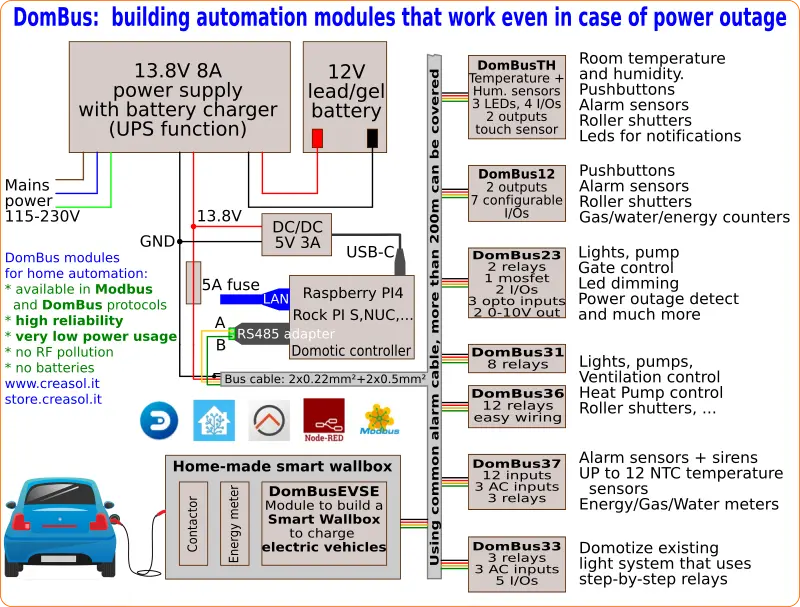
Store website - Information website
For our products we can offer FULL SUPPORT and CUSTOMIZATION: please contact us by Email or Telegram
 Complete solution to make a Smart EVSE, charging the electric vehicle using only energy from renewable source (photovoltaic, wind, ...), or adding 25-50-75-100% of available power from the grid.
Complete solution to make a Smart EVSE, charging the electric vehicle using only energy from renewable source (photovoltaic, wind, ...), or adding 25-50-75-100% of available power from the grid.
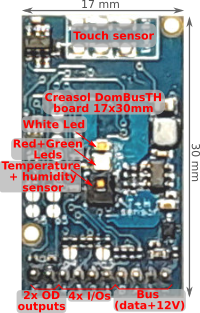 Compact board, 32x17mm, to be installed on blank cover with a 4mm hole in the middle, to exchange air for the relative humidity sensor. It can be installed in every room to monitor temperature and humidity, check alarm sensors, control blind motor UP/DOWN, send notifications (using red and green leds) and activate white led in case of power outage.
Compact board, 32x17mm, to be installed on blank cover with a 4mm hole in the middle, to exchange air for the relative humidity sensor. It can be installed in every room to monitor temperature and humidity, check alarm sensors, control blind motor UP/DOWN, send notifications (using red and green leds) and activate white led in case of power outage.
Includes:
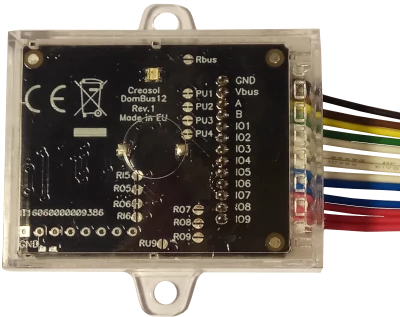 Very compact, versatile and cost-effective module with 9 ports. Each port can be configured by software as:
Very compact, versatile and cost-effective module with 9 ports. Each port can be configured by software as:
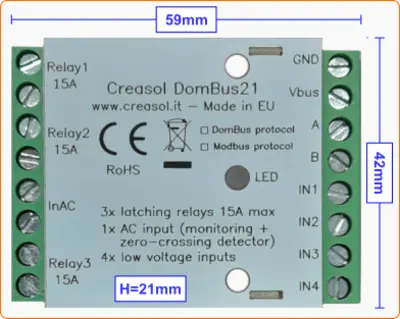 Very low power consumption module designed to enable up to 3 high power loads, up to 15A (3kW).
Very low power consumption module designed to enable up to 3 high power loads, up to 15A (3kW).
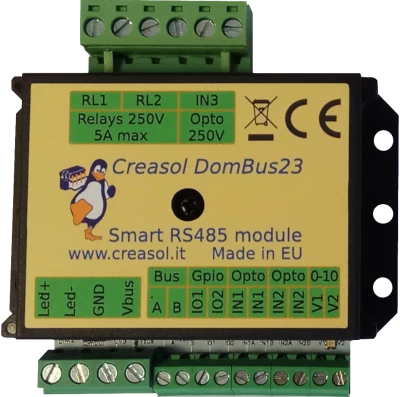 Versatile module designed to control gate or garage door.
Versatile module designed to control gate or garage door.
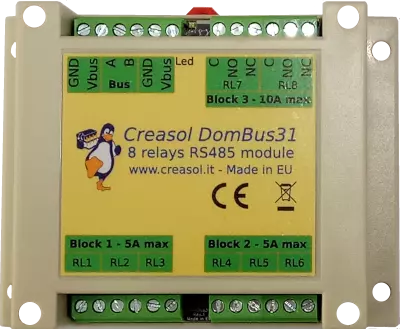 DIN rail low profile module, with 8 relays and very low power consumption:
DIN rail low profile module, with 8 relays and very low power consumption:
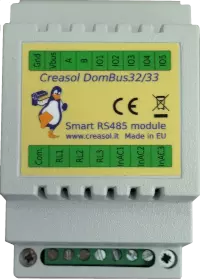 Versatile module with 230V inputs and outputs, and 5 low voltage I/Os.
Versatile module with 230V inputs and outputs, and 5 low voltage I/Os.
 Module designed to control 3 lights already existing and actually controlled by 230V pushbuttons and step-by-step relays. In this way each light can be activated by existing pushbuttons, and by the domotic controller.
Module designed to control 3 lights already existing and actually controlled by 230V pushbuttons and step-by-step relays. In this way each light can be activated by existing pushbuttons, and by the domotic controller.
Each relay can toggle the existing step-relay, switching the light On/Off. The optoisolator monitors the light status. The 5 I/Os can be connected to pushbuttons to activate or deactivate one or all lights.
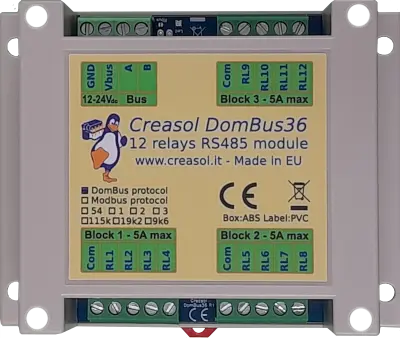 DIN rail module, low profile, with 12 relays outputs and very low power consumption.
DIN rail module, low profile, with 12 relays outputs and very low power consumption.
 Module designed to be connected to alarm sensors (magnetc contact sensors, PIRs, tampers): it's able to monitor mains power supply (power outage / blackout) and also have 3 relays outputs.
Module designed to be connected to alarm sensors (magnetc contact sensors, PIRs, tampers): it's able to monitor mains power supply (power outage / blackout) and also have 3 relays outputs.
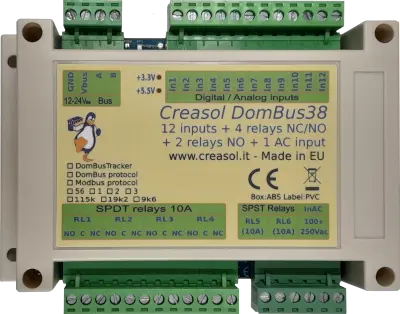 DIN rail module designed for burglar alarm system.
DIN rail module designed for burglar alarm system.
![]() DIN rail module that control azimuth + elevation/tilt motors of a sun tracker, to maximize photovoltaic energy production during the day and seasons.
DIN rail module that control azimuth + elevation/tilt motors of a sun tracker, to maximize photovoltaic energy production during the day and seasons.
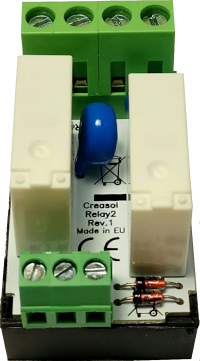 Simple module with 2 relays, to be used with DomBus modules or other electronic boards with open-collector or open-drain outputs
Simple module with 2 relays, to be used with DomBus modules or other electronic boards with open-collector or open-drain outputs
 IoT board designed for NodeMCU v3 board using ESP8266 WiFi microcontroller
IoT board designed for NodeMCU v3 board using ESP8266 WiFi microcontroller